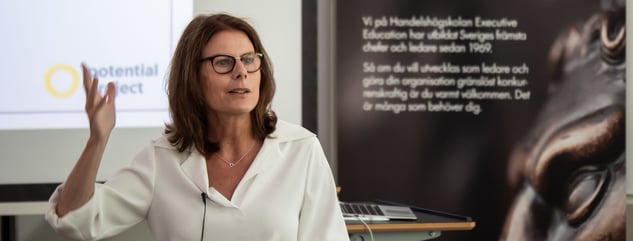
Many research reports document positive effects from mindfulness training, e.g., mindfulness-based stress reduction (MBSR). Eidmann’s research looks at mindfulness from a leadership and organizational perspective.
Below, she explains (i) why stakeholders should invest in sustainable leadership and organizations and (ii) how mindfulness is used in the Sustainable Leadership program at the Stockholm School of Economics.
Why should stakeholders, such as executives, managers, and leaders, participate in the Sustainable Leadership program?
– Mindful stakeholders can make a huge difference for themselves and others. For leaders, knowledge gained via the program forms a firm foundation on which they can operate – thanks to (i) increased awareness of their modus operandi (habits) as humans and leaders and (ii) knowledge about effects from stress and how the brain works.
The ability to select and act out a specific behavior is necessary but difficult – due to pervasive technology that constantly distracts and interrupts thoughts and actions. To create new habits, program participants learn about mindfulness and practice it. Compassion is the icing on the cake; it’s about being a little kinder to themselves and others and being able to create psychological security for the employees who receive direction under program participants’ leadership.
The program is unique and based on the latest research from various fields. That said, it isn’t mainstream – but rather at the forefront.
What are your contributions to the program?
– A holistic perspective, research, and experiences (mine and others’). Since 2006, I’ve gained extensive management and leadership experience. I participated in executive teams and worked as a consultant for personal development and leadership issues.
I studied how humans function and how the brain works. These studies formed the foundation for being able to make it through the long haul, to feel better, and to be a better leader.
Briefly describe MBSR and corporate mindfulness.
– Jon Kabat-Zinn launched the mindfulness-based stress reduction program in 1979 at the University of Massachusetts Medical Center. He holds the patent on MBSR. After several years practicing meditation and experiences from several retreats, Kabat-Zinn thought that this approach should be accessible to more people so that they could reduce unnecessary stress and suffering in their lives and thus live better lives. He started a stress reduction clinic for patients with severe chronic illnesses who were considered untreatable. The results were fantastic. Patients had a 30–35% reduction in physical symptoms and 40–50% reduction in mental symptoms – plus improved quality of life.
"In an MBSR program, participants practice 40–45 minutes per day
for 8 weeks, 6 days a week. It had a rehabilitative purpose
from the beginning."
– Corporate mindfulness training is a variation of MBSR. Unfortunately, some mindfulness training skeptics perceive it as light-weight (flimsy, contrived). That said, results from studies on mindfulness training demonstrate the opposite (e.g., 216 studies between 2013 and 2015).
Terminology used in corporate mindfulness training is aligned with corporate- or company-specific language – to be more attractive and to neutralize negativity. The practice sessions run for 10 minutes per day. It's about training the brain's ability to pay attention so that practitioners stay focused and calm when they find themselves in the midst of chaos that can occur at work.
Mindfulness training is about paying attention, accepting and taking control of thoughts, turning off the autopilot, and eliminating multi-tasking. The result? More efficiency and productivity – besides reduced stress and improved quality of life.
Corporate mindfulness training is also a proactive tool. Participants learn to make more conscious choices. And they avoid excessive distraction and stress that can eventually lead to burnout.
How much practice is necessary?
– The more participants practice, the better they get – just like when they physically exercise their bodies. Ten minutes per day makes a huge difference – compared to nothing.
Sustainable Leadership program
The nine-day Sustainable Leadership program helps organizations break negative trends. How? By making managers more competent and versatile. Leaders get tools and strategies to better manage their work situations, while getting other tools to push the rest of the organization in the right direction.
Find out more
Contact Karolina Bardland by e-mail karolina.bardland@exedsse.se. Or call +46 70 738 36 33. You can also download program information by using the form on this page.
 Jeannette Eidmann is director of the Sustainable Leadership program within the SSE Executive Education department. In parallel, she is a doctoral student at the Stockholm School of Economics. She started her career as a business economist, earned an M.Sc. in Gestalt i Organisation and has worked extensively with leadership development and executive team development since 2006. She is certified in neuroleadership and holds a mindfulness instruction certificate (from the Neuroleadership Institute within the Mindfulness and Compassion program)
Jeannette Eidmann is director of the Sustainable Leadership program within the SSE Executive Education department. In parallel, she is a doctoral student at the Stockholm School of Economics. She started her career as a business economist, earned an M.Sc. in Gestalt i Organisation and has worked extensively with leadership development and executive team development since 2006. She is certified in neuroleadership and holds a mindfulness instruction certificate (from the Neuroleadership Institute within the Mindfulness and Compassion program)

